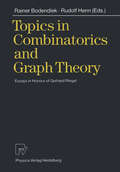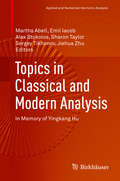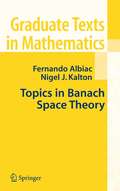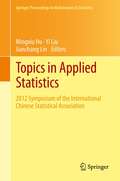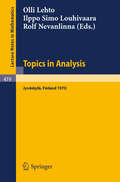- Table View
- List View
Topics in Domination in Graphs: Advanced Topics (Developments in Mathematics #64)
by Teresa W. Haynes Stephen T. Hedetniemi Michael A. HenningThis volume comprises 16 contributions that present advanced topics in graph domination, featuring open problems, modern techniques, and recent results. The focus is on primary dominating sets such as paired domination, connected domination, restrained domination, dominating functions, Roman domination, and power domination. Additionally, surveys include known results with a sample of proof techniques for each parameter. Of extra benefit to the reader, the first chapter includes a glossary of commonly used terms; the second chapter provides an overview of models of domination from which the parameters are defined. The book is intended to provide a reference for established researchers in the fields of domination and graph theory and graduate students who wish to gain knowledge of the topics covered as well as an overview of the major accomplishments in the field and proof techniques used.
Topics in Disordered Systems (Lectures in Mathematics. ETH Zürich)
by Charles M. NewmanDisordered systems are statistical mechanics models in random environments. This lecture notes volume concerns the equilibrium properties of a few carefully chosen examples of disordered Ising models. The approach is that of probability theory and mathematical physics, but the subject matter is of interest also to condensed matter physicists, material scientists, applied mathematicians and theoretical computer scientists. (The two main types of systems considered are disordered ferromagnets and spin glasses. The emphasis is on questions concerning the number of ground states (at zero temperature) or the number of pure Gibbs states (at nonzero temperature). A recurring theme is that these questions are connected to interesting issues concerning percolation and related models of geometric/combinatorial probability. One question treated at length concerns the low temperature behavior of short-range spin glasses: whether and in what sense Parisi's analysis of the meanfield (or "infinite-range") model is relevant. Closely related is the more general conceptual issue of how to approach the thermodynamic (i.e., infinite volume) limit in systems which may have many complex competing states. This issue has been addressed in recent joint work by the author and Dan Stein and the book provides a mathematically coherent presentation of their approach.)
Topics in Discrete Mathematics: Dedicated to Jarik Nešetril on the Occasion of his 60th birthday (Algorithms and Combinatorics #26)
by Martin Klazar Jan Kratochvil Martin Loebl Robin Thomas Pavel ValtrThis book comprises a collection of high quality papers in selected topics of Discrete Mathematics, to celebrate the 60th birthday of Professor Jarik Nešetril. Leading experts have contributed survey and research papers in the areas of Algebraic Combinatorics, Combinatorial Number Theory, Game theory, Ramsey Theory, Graphs and Hypergraphs, Homomorphisms, Graph Colorings and Graph Embeddings.
Topics in Control Theory: A Seminar Given at the Forschungsinstitut für Mathematik, ETH in Zürich 1964 (Lecture Notes in Mathematics #63)
by Felix AlbrechtTopics in Computational Wave Propagation: Direct and Inverse Problems (Lecture Notes in Computational Science and Engineering #31)
by Mark Ainsworth Penny Davies Dugald B. Duncan Paul A. Martin Bryan RynneThese ten detailed and authoritative survey articles on numerical methods for direct and inverse wave propagation problems are written by leading experts. Researchers and practitioners in computational wave propagation, from postgraduate level onwards, will find the breadth and depth of coverage of recent developments a valuable resource. The articles describe a wide range of topics on the application and analysis of methods for time and frequency domain PDE and boundary integral formulations of wave propagation problems. Electromagnetic, seismic and acoustic equations are considered. Recent developments in methods and analysis ranging from finite differences to hp-adaptive finite elements, including high-accuracy and fast methods are described with extensive references.
Topics in Computational Algebra
by G. M. Piacentini Cattaneo Elisabetta StricklandThe main purpose of these lectures is first to briefly survey the fundamental con nection between the representation theory of the symmetric group Sn and the theory of symmetric functions and second to show how combinatorial methods that arise naturally in the theory of symmetric functions lead to efficient algorithms to express various prod ucts of representations of Sn in terms of sums of irreducible representations. That is, there is a basic isometry which maps the center of the group algebra of Sn, Z(Sn), to the space of homogeneous symmetric functions of degree n, An. This basic isometry is known as the Frobenius map, F. The Frobenius map allows us to reduce calculations involving characters of the symmetric group to calculations involving Schur functions. Now there is a very rich and beautiful theory of the combinatorics of symmetric functions that has been developed in recent years. The combinatorics of symmetric functions, then leads to a number of very efficient algorithms for expanding various products of Schur functions into a sum of Schur functions. Such expansions of products of Schur functions correspond via the Frobenius map to decomposing various products of irreducible representations of Sn into their irreducible components. In addition, the Schur functions are also the characters of the irreducible polynomial representations of the general linear group over the complex numbers GLn(C).
Topics in Complex Analysis (Universitext)
by Mats AnderssonThis book is an outgrowth of lectures given on several occasions at Chalmers University of Technology and Goteborg University during the last ten years. As opposed to most introductory books on complex analysis, this one as sumes that the reader has previous knowledge of basic real analysis. This makes it possible to follow a rather quick route through the most fundamen tal material on the subject in order to move ahead to reach some classical highlights (such as Fatou theorems and some Nevanlinna theory), as well as some more recent topics (for example, the corona theorem and the HI_ BMO duality) within the time frame of a one-semester course. Sections 3 and 4 in Chapter 2, Sections 5 and 6 in Chapter 3, Section 3 in Chapter 5, and Section 4 in Chapter 7 were not contained in my original lecture notes and therefore might be considered special topics. In addition, they are completely independent and can be omitted with no loss of continuity. The order of the topics in the exposition coincides to a large degree with historical developments. The first five chapters essentially deal with theory developed in the nineteenth century, whereas the remaining chapters contain material from the early twentieth century up to the 1980s. Choosing methods of presentation and proofs is a delicate task. My aim has been to point out connections with real analysis and harmonic anal ysis, while at the same time treating classical complex function theory.
Topics in Commutative Ring Theory
by John J. WatkinsTopics in Commutative Ring Theory is a textbook for advanced undergraduate students as well as graduate students and mathematicians seeking an accessible introduction to this fascinating area of abstract algebra. Commutative ring theory arose more than a century ago to address questions in geometry and number theory. A commutative ring is a set-such as the integers, complex numbers, or polynomials with real coefficients--with two operations, addition and multiplication. Starting from this simple definition, John Watkins guides readers from basic concepts to Noetherian rings-one of the most important classes of commutative rings--and beyond to the frontiers of current research in the field. Each chapter includes problems that encourage active reading--routine exercises as well as problems that build technical skills and reinforce new concepts. The final chapter is devoted to new computational techniques now available through computers. Careful to avoid intimidating theorems and proofs whenever possible, Watkins emphasizes the historical roots of the subject, like the role of commutative rings in Fermat's last theorem. He leads readers into unexpected territory with discussions on rings of continuous functions and the set-theoretic foundations of mathematics. Written by an award-winning teacher, this is the first introductory textbook to require no prior knowledge of ring theory to get started. Refreshingly informal without ever sacrificing mathematical rigor, Topics in Commutative Ring Theory is an ideal resource for anyone seeking entry into this stimulating field of study.
Topics in Commutative Ring Theory
by John J. WatkinsTopics in Commutative Ring Theory is a textbook for advanced undergraduate students as well as graduate students and mathematicians seeking an accessible introduction to this fascinating area of abstract algebra. Commutative ring theory arose more than a century ago to address questions in geometry and number theory. A commutative ring is a set-such as the integers, complex numbers, or polynomials with real coefficients--with two operations, addition and multiplication. Starting from this simple definition, John Watkins guides readers from basic concepts to Noetherian rings-one of the most important classes of commutative rings--and beyond to the frontiers of current research in the field. Each chapter includes problems that encourage active reading--routine exercises as well as problems that build technical skills and reinforce new concepts. The final chapter is devoted to new computational techniques now available through computers. Careful to avoid intimidating theorems and proofs whenever possible, Watkins emphasizes the historical roots of the subject, like the role of commutative rings in Fermat's last theorem. He leads readers into unexpected territory with discussions on rings of continuous functions and the set-theoretic foundations of mathematics. Written by an award-winning teacher, this is the first introductory textbook to require no prior knowledge of ring theory to get started. Refreshingly informal without ever sacrificing mathematical rigor, Topics in Commutative Ring Theory is an ideal resource for anyone seeking entry into this stimulating field of study.
Topics in Combinatorics and Graph Theory: Essays in Honour of Gerhard Ringel
by Rainer Bodendiek Rudolf HennGraph Theory is a part of discrete mathematics characterized by the fact of an extremely rapid development during the last 10 years. The number of graph theoretical paper as well as the number of graph theorists increase very strongly. The main purpose of this book is to show the reader the variety of graph theoretical methods and the relation to combinatorics and to give him a survey on a lot of new results, special methods, and interesting informations. This book, which grew out of contributions given by about 130 authors in honour to the 70th birthday of Gerhard Ringel, one of the pioneers in graph theory, is meant to serve as a source of open problems, reference and guide to the extensive literature and as stimulant to further research on graph theory and combinatorics.
Topics in Combinatorial Group Theory (Lectures in Mathematics. ETH Zürich)
by Gilbert BaumslagCombinatorial group theory is a loosely defined subject, with close connections to topology and logic. With surprising frequency, problems in a wide variety of disciplines, including differential equations, automorphic functions and geometry, have been distilled into explicit questions about groups, typically of the following kind: Are the groups in a given class finite (e.g., the Burnside problem)? Finitely generated? Finitely presented? What are the conjugates of a given element in a given group? What are the subgroups of that group? Is there an algorithm for deciding for every pair of groups in a given class whether they are isomorphic or not? The objective of combinatorial group theory is the systematic development of algebraic techniques to settle such questions. In view of the scope of the subject and the extraordinary variety of groups involved, it is not surprising that no really general theory exists. These notes, bridging the very beginning of the theory to new results and developments, are devoted to a number of topics in combinatorial group theory and serve as an introduction to the subject on the graduate level.
Topics in Cohomology of Groups (Lecture Notes in Mathematics #1625)
by Serge LangThe book is a mostly translated reprint of a report on cohomology of groups from the 1950s and 1960s, originally written as background for the Artin-Tate notes on class field theory, following the cohomological approach. This report was first published (in French) by Benjamin. For this new English edition, the author added Tate's local duality, written up from letters which John Tate sent to Lang in 1958 - 1959. Except for this last item, which requires more substantial background in algebraic geometry and especially abelian varieties, the rest of the book is basically elementary, depending only on standard homological algebra at the level of first year graduate students.
Topics in Cohomological Studies of Algebraic Varieties: Impanga Lecture Notes (Trends in Mathematics)
by Piotr PragaczThe articles in this volume study various cohomological aspects of algebraic varieties:- characteristic classes of singular varieties;- geometry of flag varieties;- cohomological computations for homogeneous spaces;- K-theory of algebraic varieties;- quantum cohomology and Gromov-Witten theory.The main purpose is to give comprehensive introductions to the above topics through a series of "friendly" texts starting from a very elementary level and ending with the discussion of current research. In the articles, the reader will find classical results and methods as well as new ones. Numerous examples will help to understand the mysteries of the cohomological theories presented. The book will be a useful guide to research in the above-mentioned areas. It is adressed to researchers and graduate students in algebraic geometry, algebraic topology, and singularity theory, as well as to mathematicians interested in homogeneous varieties and symmetric functions. Most of the material exposed in the volume has not appeared in books before.Contributors:Paolo AluffiMichel BrionAnders Skovsted BuchHaibao DuanAli Ulas Ozgur KisiselPiotr PragaczJörg SchürmannMarek SzyjewskiHarry Tamvakis
Topics in Clifford Analysis: Special Volume in Honor of Wolfgang Sprößig (Trends in Mathematics)
by Swanhild BernsteinQuaternionic and Clifford analysis are an extension of complex analysis into higher dimensions. The unique starting point of Wolfgang Sprößig’s work was the application of quaternionic analysis to elliptic differential equations and boundary value problems. Over the years, Clifford analysis has become a broad-based theory with a variety of applications both inside and outside of mathematics, such as higher-dimensional function theory, algebraic structures, generalized polynomials, applications of elliptic boundary value problems, wavelets, image processing, numerical and discrete analysis. The aim of this volume is to provide an essential overview of modern topics in Clifford analysis, presented by specialists in the field, and to honor the valued contributions to Clifford analysis made by Wolfgang Sprößig throughout his career.
Topics in Classical and Modern Analysis: In Memory of Yingkang Hu (Applied and Numerical Harmonic Analysis)
by Martha Abell Emil Iacob Alex Stokolos Sharon Taylor Sergey Tikhonov Jiehua ZhuDifferent aspects of harmonic analysis, complex analysis, sampling theory, approximation theory and related topics are covered in this volume. The topics included are Fourier analysis, Padè approximation, dynamical systems and difference operators, splines, Christoffel functions, best approximation, discrepancy theory and Jackson-type theorems of approximation. The articles of this collection were originated from the International Conference in Approximation Theory, held in Savannah, GA in 2017, and organized by the editors of this volume.
Topics in Calculus of Variations: Lectures given at the 2nd 1987 Session of the Centro Internazionale Matematico Estivo (C.I.M.E.) held at Montecatini Terme, Italy, July 20-28, 1987 (Lecture Notes in Mathematics #1365)
by Mariano GiaquintaTopics in Banach Space Theory (Graduate Texts in Mathematics #233)
by Fernando Albiac Nigel J. KaltonThis text provides the reader with the necessary technical tools and background to reach the frontiers of research without the introduction of too many extraneous concepts. Detailed and accessible proofs are included, as are a variety of exercises and problems. The two new chapters in this second edition are devoted to two topics of much current interest amongst functional analysts: Greedy approximation with respect to bases in Banach spaces and nonlinear geometry of Banach spaces. This new material is intended to present these two directions of research for their intrinsic importance within Banach space theory, and to motivate graduate students interested in learning more about them.This textbook assumes only a basic knowledge of functional analysis, giving the reader a self-contained overview of the ideas and techniques in the development of modern Banach space theory. Special emphasis is placed on the study of the classical Lebesgue spaces Lp (and their sequence space analogues) and spaces of continuous functions. The authors also stress the use of bases and basic sequences techniques as a tool for understanding the isomorphic structure of Banach spaces.From the reviews of the First Edition:"The authors of the book…succeeded admirably in creating a very helpful text, which contains essential topics with optimal proofs, while being reader friendly… It is also written in a lively manner, and its involved mathematical proofs are elucidated and illustrated by motivations, explanations and occasional historical comments… I strongly recommend to every graduate student who wants to get acquainted with this exciting part of functional analysis the instructive and pleasant reading of this book…"—Gilles Godefroy, Mathematical Reviews
Topics in Banach Space Theory (Graduate Texts in Mathematics #233)
by Fernando Albiac Nigel J. KaltonThis book emphasizes the isomorphic theory of Banach spaces and techniques using the unifying viewpoint of basic sequences. Its aim is to provide the reader with the necessary technical tools and background to reach the frontiers of research without the introduction of too many extraneous concepts. Detailed and accessible proofs are included, as are a variety of exercises and problems.
Topics in Atomic and Nuclear Collisions (Nato Science Series B: #321)
by B. Remaud A. Calboreanu V. ZoranThe ASI 'Topics in Atomic and Nuclear Collisions' was organized in Predeal from August 31 to September 11. It brought together people with a broad interest in Atomic and Nuclear Physics from several research institutes and universities in Ro mania and 16 other countries. The school continues a tradition that started on a small scale back in 1968, fo cussing mainly on current problems in nuclear physics. Though the organizing of this edition started very late and in very uncertain economic and financial conditions, it turned out to be the largest meeting of this type ever organized in Romania, both in topics and participation. There were many applicants for participation and grants, considerably more than could be handled. The selection made by the local organizing committee was based on the following criteria: a proper balance of atomic and nuclear physicists, a broad representation of people from Research Institutes and Universities, a balanced par ticipat!on with respect to age, sex, nationality and observance of ASI requirements.
Topics in Applied Statistics: 2012 Symposium of the International Chinese Statistical Association (Springer Proceedings in Mathematics & Statistics #55)
by Mingxiu Hu, Yi Liu and Jianchang LinThis volume presents 27 selected papers in topics that range from statistical applications in business and finance to applications in clinical trials and biomarker analysis. All papers feature original, peer-reviewed content. The editors intentionally selected papers that cover many topics so that the volume will serve the whole statistical community and a variety of research interests. The papers represent select contributions to the 21st ICSA Applied Statistics Symposium. The International Chinese Statistical Association (ICSA) Symposium took place between the 23rd and 26th of June, 2012 in Boston, Massachusetts. It was co-sponsored by the International Society for Biopharmaceutical Statistics (ISBS) and American Statistical Association (ASA). This is the inaugural proceedings volume to share research from the ICSA Applied Statistics Symposium.
Topics in Applied Analysis and Optimisation: Partial Differential Equations, Stochastic and Numerical Analysis (CIM Series in Mathematical Sciences)
This volume comprises selected, revised papers from the Joint CIM-WIAS Workshop, TAAO 2017, held in Lisbon, Portugal, in December 2017. The workshop brought together experts from research groups at the Weierstrass Institute in Berlin and mathematics centres in Portugal to present and discuss current scientific topics and to promote existing and future collaborations. The papers include the following topics: PDEs with applications to material sciences, thermodynamics and laser dynamics, scientific computing, nonlinear optimization and stochastic analysis.
Topics in Analytic Number Theory (Grundlehren der mathematischen Wissenschaften #169)
by Hans RademacherAt the time of Professor Rademacher's death early in 1969, there was available a complete manuscript of the present work. The editors had only to supply a few bibliographical references and to correct a few misprints and errors. No substantive changes were made in the manu script except in one or two places where references to additional material appeared; since this material was not found in Rademacher's papers, these references were deleted. The editors are grateful to Springer-Verlag for their helpfulness and courtesy. Rademacher started work on the present volume no later than 1944; he was still working on it at the inception of his final illness. It represents the parts of analytic number theory that were of greatest interest to him. The editors, his students, offer this work as homage to the memory of a great man to whom they, in common with all number theorists, owe a deep and lasting debt. E. Grosswald Temple University, Philadelphia, PA 19122, U.S.A. J. Lehner University of Pittsburgh, Pittsburgh, PA 15213 and National Bureau of Standards, Washington, DC 20234, U.S.A. M. Newman National Bureau of Standards, Washington, DC 20234, U.S.A. Contents I. Analytic tools Chapter 1. Bernoulli polynomials and Bernoulli numbers ....... . 1 1. The binomial coefficients ..................................... . 1 2. The Bernoulli polynomials .................................... . 4 3. Zeros of the Bernoulli polynomials ............................. . 7 4. The Bernoulli numbers ....................................... . 9 5. The von Staudt-Clausen theorem .............................. . 10 6. A multiplication formula for the Bernoulli polynomials ........... .
Topics in Analysis and its Applications (Nato Science Series II: #147)
by Grigor A. Barsegian Heinrich G. W. BegehrMost topics dealt with here deal with complex analysis of both one and several complex variables. Several contributions come from elasticity theory. Areas covered include the theory of p-adic analysis, mappings of bounded mean oscillations, quasiconformal mappings of Klein surfaces, complex dynamics of inverse functions of rational or transcendental entire functions, the nonlinear Riemann-Hilbert problem for analytic functions with nonsmooth target manifolds, the Carleman-Bers-Vekua system, the logarithmic derivative of meromorphic functions, G-lines, computing the number of points in an arbitrary finite semi-algebraic subset, linear differential operators, explicit solution of first and second order systems in bounded domains degenerating at the boundary, the Cauchy-Pompeiu representation in L2 space, strongly singular operators of Calderon-Zygmund type, quadrature solutions to initial and boundary-value problems, the Dirichlet problem, operator theory, tomography, elastic displacements and stresses, quantum chaos, and periodic wavelets.








